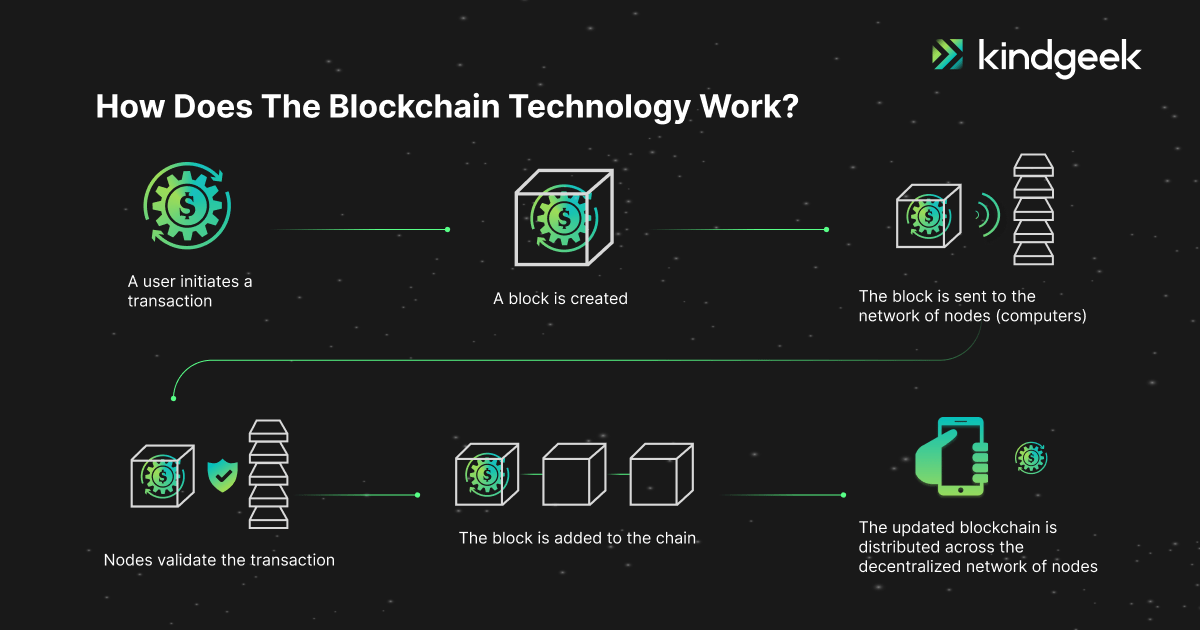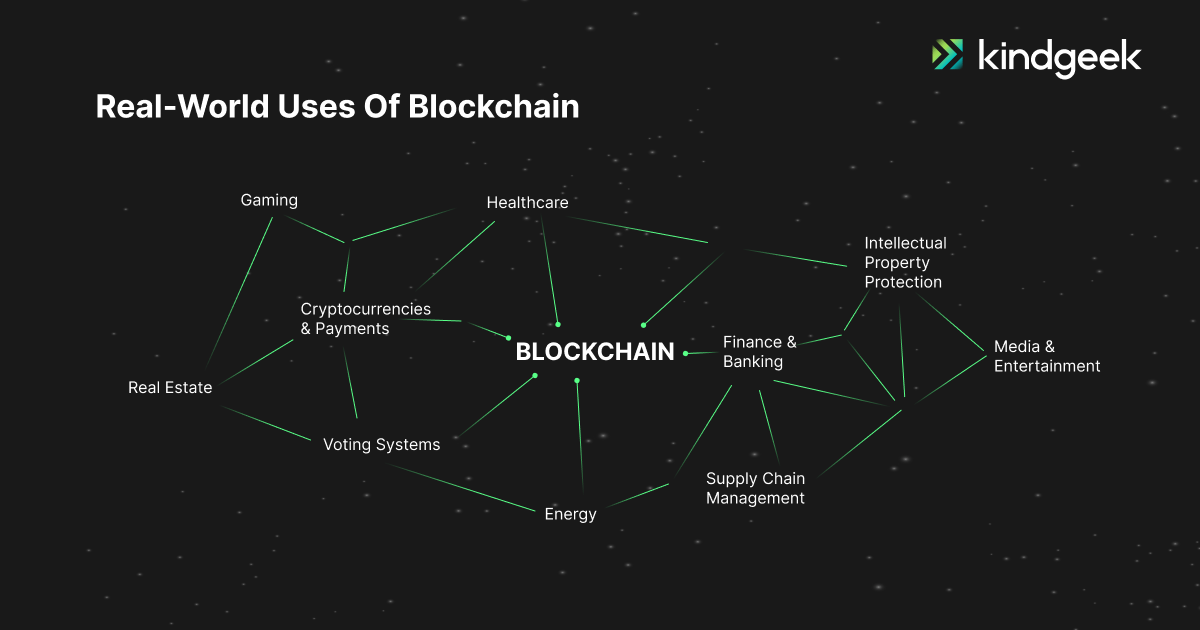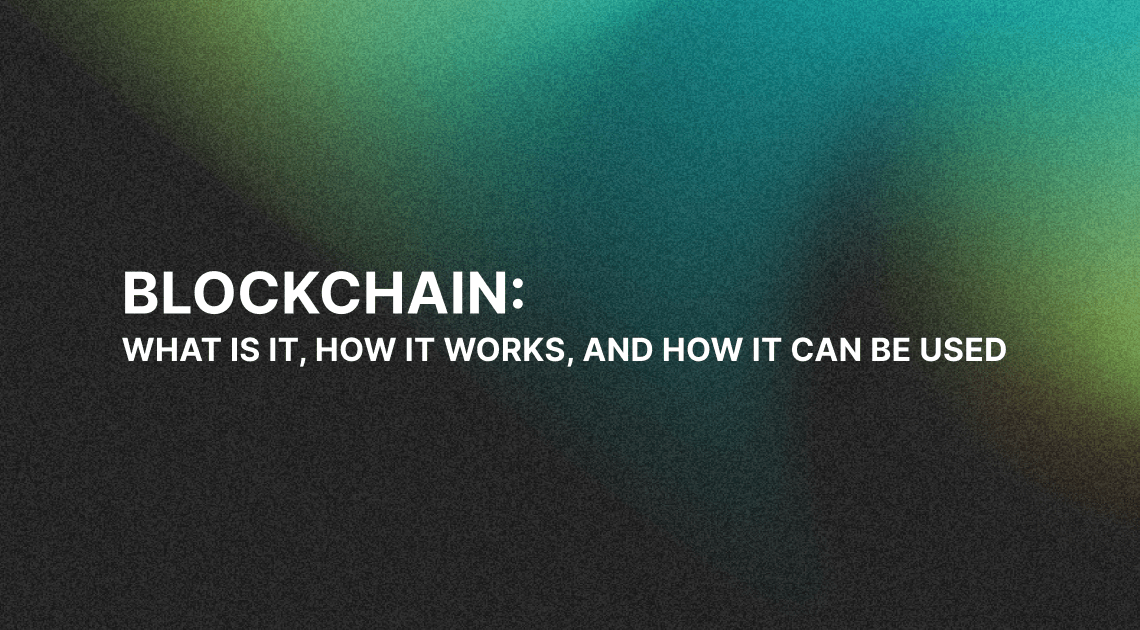Recently updated on April 18, 2025
Initially introduced as the foundation for cryptocurrencies like Bitcoin, blockchain has since expanded its reach into various industries, offering unparalleled transparency, security, and efficiency benefits.
But what is blockchain exactly?
This technology aims to decentralize control, removing the need for a central authority and giving users more autonomy over their data and transactions.
Here, we uncover the essence of blockchain, how it operates, its various types, and its potential applications in the modern world.
Understanding Blockchain Technology
A blockchain is a digital ledger system that records transactions and tracks assets. This innovative technology operates as a decentralized and distributed network, ensuring data is shared across multiple nodes rather than stored in a central location.
It is like a spreadsheet copied across a network of computers thousands of times and regularly updated in the network. Each entry in the blockchain, known as a block, links to the one before it, forming a chain of records that is nearly impossible to tamper with.
How Does Blockchain Work?
The key components of blockchain technology are:
Distributed Ledger
A decentralized database that records all transactions across a network of computers (nodes). Unlike traditional ledgers maintained by a central authority, the distributed ledger ensures that all participants have an identical copy of the data, enhancing transparency and preventing fraud, double-spending, or unauthorized changes.
Blocks
A blockchain is built from a series of blocks, each containing:
- Data and transactions: Information such as transaction details, timestamps, or other relevant records.
- Hash: A unique identifier generated from the data in the block. This acts as a digital fingerprint.
- Previous hash: The hash of the preceding block, ensuring each block is linked to the next.
Consensus Mechanism
Blockchain relies on consensus algorithms to validate transactions and add blocks to the chain. Common mechanisms include:
- Proof of Work (PoW): Requires computational effort to find a valid nonce (short for “number used once”), a random number used to solve cryptographic puzzles and validate new blocks.
- Proof of Stake (PoS): Validators are chosen based on their stake in the network.
- Other mechanisms, like Delegated Proof of Stake (DPoS) or Practical Byzantine Fault Tolerance (PBFT).
Smart Contracts
These are self-executing contracts with predefined rules encoded directly into the blockchain. They automate and enforce agreements without intermediaries.
Cryptography
Blockchain uses advanced cryptographic techniques to secure data and ensure transaction authenticity.
- Hashing: Converts input data into a fixed-size string of characters, making it virtually impossible to reverse-engineer.
- Public and private keys: Public keys act as an address for transactions, while private keys are used to sign transactions securely.
So, how does the blockchain technology work?

1. A user initiates a transaction.
This could involve sending cryptocurrency, transferring NFT ownership, or executing a DeFi smart contract.
2. A block is created.
The transaction is recorded as a data block with key details like the sender, receiver, and the data or value being exchanged.
3. The block is sent to the network of nodes (computers).
The transaction is broadcast to the blockchain network, where it waits to be validated.
4. Nodes validate the transaction.
Network nodes verify the transaction through a consensus mechanism. Validation ensures that the transaction is legitimate (e.g., the sender has sufficient funds or meets the conditions of a smart contract).
5. The block is added to the chain.
Once validated, the block is added to the chain in chronological order. It includes a hash for its data and references the previous block’s hash, creating a sequential link. This linkage ensures the immutability of the blockchain—any tampering would disrupt the entire chain.
6. The updated blockchain is distributed across the decentralized network of nodes.
Once the block is added, the updated blockchain is shared across all nodes in the network. Each node updates its copy of the blockchain, ensuring that all participants have the same version of the ledger. This shared ledger grows continuously as more blocks are added.
Exploring Different Blockchain Models
Blockchain technology has evolved to serve a variety of purposes, resulting in different types of blockchain models. Each model caters to specific use cases and offers unique benefits and trade-offs:
- Public Blockchains: Open to anyone, public blockchains are decentralized and allow users to participate in the validation process.
- Private Blockchains: These are restricted networks, with access limited to selected participants. Enterprises commonly use private blockchains for internal processes.
- Consortium Blockchains (Federated Blockchains): A hybrid model where a group of organizations jointly manages the blockchain.
- Hybrid Blockchains: A combination of public and private blockchains allowing certain data to be accessible publicly while keeping sensitive information private.
Where and How To Use Blockchain?
The blockchain industry has grown far beyond its origins in cryptocurrency. Its unique properties enable a wide range of crypto solutions development across various sectors.

Cryptocurrencies and Payments
Unlike traditional bank systems that rely on intermediaries, blockchain enables direct peer-to-peer transactions and makes them faster, cheaper, and more secure. Popular examples include Bitcoin (BTC) for secure digital payments, Ethereum (ETH) for smart contracts and decentralized applications (dApps), stablecoins (USDT, USDC) for transaction price stability, and Ripple (XRP) for international money transfers.
Finance and Banking
Blockchain offers efficiency, security, and transparency in financial transactions. With decentralized finance (DeFi) on the rise, more and more platforms are emerging to enable people to borrow, lend, and trade assets without intermediaries. Some of these platforms are Uniswap, PancakeSwap, Curve, and Binance.
Supply Chain Management
Another blockchain example is its use in supply chains, where real-time tracking and transparent records enhance efficiency and accountability.
Companies experimenting with blockchain include IBM, Walmart, Pfizer, AIG, Siemens, and Unilever, among others.
Healthcare
Blockchains can be used in healthcare to securely store patient records, enable data sharing among authorized parties, and improve data integrity. It can also provide end-to-end tracking of pharmaceutical products to ensure drug authenticity and proper handling.
Voting Systems
Blockchain can help create tamper-proof digital voting systems to enhance trust and transparency during elections.
Intellectual Property Protection
Smart contracts on blockchains can enforce copyright laws and protect creators’ intellectual property rights.
Real Estate
Blockchain simplifies property transactions, reducing fraud and improving transparency through digital deeds and smart contracts.
Energy
Blockchain can improve efficiency in energy trading and distribution by enabling peer-to-peer energy transactions.
A recent partnership between Enel and Algorand leverages blockchain to enable Italians to acquire virtual shares in solar energy plants, promoting direct citizen participation in renewable energy production.
Media and Entertainment
Blockchains are transforming the media and entertainment industry by solving challenges related to copyright protection, royalty distribution, and fan engagement.
Gaming
The technology is also revolutionizing gaming by introducing new models of ownership, monetization, and fair gameplay. Players can own in-game items (e.g., skins, weapons) as NFTs, which they can trade or sell independently.
Blockchain-based games reward players with tokens or cryptocurrency, allowing them to monetize their time and efforts.
Blockchain isn’t just changing how we do business—it’s redefining trust, ownership, and innovation in ways we couldn’t imagine a decade ago. It has already left a mark on industries like finance, healthcare, supply chains and beyond, proving its potential to solve real-world problems.
Looking ahead, the future of blockchain feels limitless. As the technology matures, it could open doors to a more decentralized, fair, and inclusive digital landscape. Whether it’s powering global economies or giving individuals more control over their data, blockchain is shaping up to be a cornerstone of the future internet.




